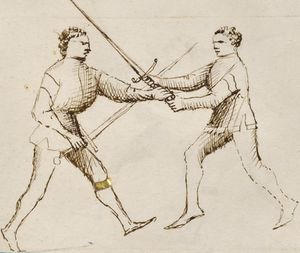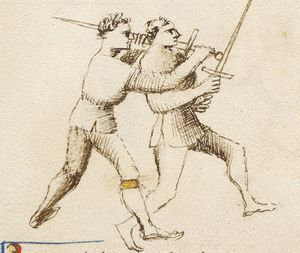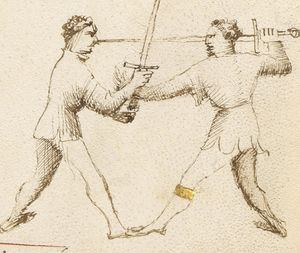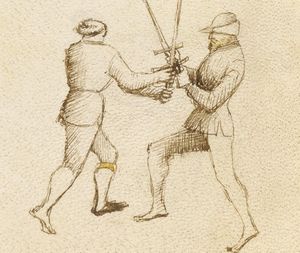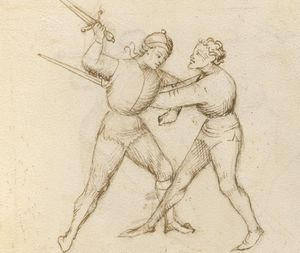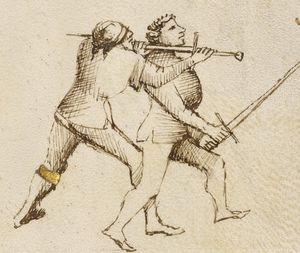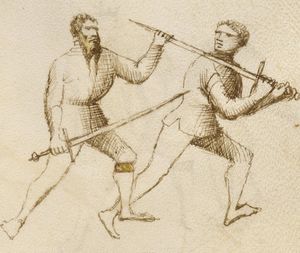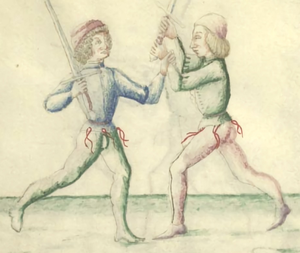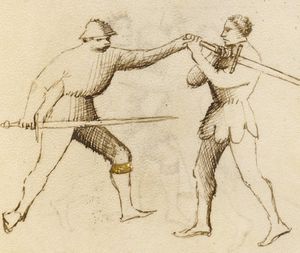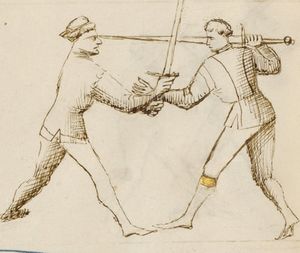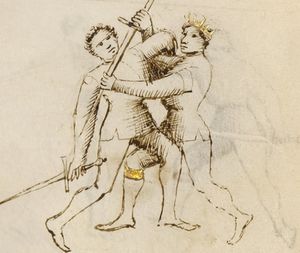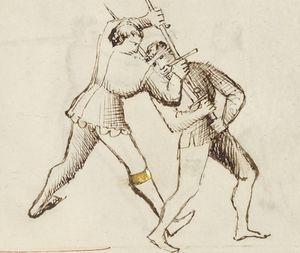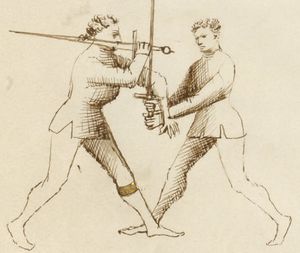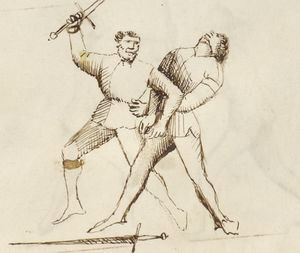|
|
You are not currently logged in. Are you accessing the unsecure (http) portal? Click here to switch to the secure portal. |
Fiore de'i Liberi/Sword in Two Hands/Narrow Play
Images |
Images |
PD |
Morgan Transcription [edit] |
Getty Transcription [edit] |
|||
|---|---|---|---|---|---|---|---|
| [No Image] |
[48] Here commences play of gioco stretto (narrow play) with a sword two-handed, in which it will be of every reason covers and injuries and binds and dislocations and grips and disarms of swords and beats (sbatter) to the ground in diverse ways. And there will be remedies and their counters of every reason, which you need to offend or defend. |
Here begins the play of the sword in two hands, the narrow play, the method of breaking all thrusts and cuts, in the which will be every method of covering, striking, and binding, and dislocations, and grapples, and takings of the sword, and beating to the ground in diverse ways. And there will be remedies and counters of every category that should offend or defend. |
[16r-t] E qui comenza zogo de spada a doi mane, zogo stretto. E'l modo de rompe tute punte e tagli. In lo quale serano d'ogni rasone, coverte, feride, e ligadure, e dislogadure, e prese, e tore de spada, e sbatere in terra, per diversi modi. E serano gli remedii, e gli contrarii de zaschuna rasone che bisogna a offendere e difendere. |
||||
[49] Because of the way that we stand here crossed, We stay here crossed, and from this crossing which we do, we can do all the following plays, one of us as the other one. And all these plays will follow one another, as I said before. |
We stand here crossed and from this crossing that we make, all the plays that follow us can be made, and by one of us as easily as the other. And all of these plays will follow, one after the other, as was previously said. |
[16r-a] Nui stasemo qui incrosadi e di questo incrosare che noii fazemo. Tuti gli zoghi che noii segueno fargle possemo. Acosi uno de noii, quale l'altro. E tuti gli zoghi seguirano uno l'altro como denanci e dito. |
|
[22a-a] Per modo che noii stasemo aqui incrosadi |
|||
[50] Because of your hilt which I hold in my hand, Because of the crossing that the Master did, with the right foot forward, I complete the first play, that is: I pass [forward] with the left foot, and with my left hand I pass over my right arm and grab the handle of his sword in the middle of his hands, in the middle of his handle. And with cuts (taglio) and thrusts I can injure him. And this grip can be done with one-handed sword or two-handed sword. The crossing can be done either from above or under-hand if making this grip. |
From the crossing that the Master has made with his right foot forward, I complete the first play—that is, I step with my left foot and I pass my left hand over my [right] arm and grasp the hilt of his sword in between his hands (in the middle of the hilt), and then I could strike with edge and point. And this catch can be made as easily with the sword in one hand as with the sword in two hands, and this catch can be made as easily crossing under the hands as over. [In the Paris, the Scholar's sword is in front of his arm.] |
[16r-b] Per lo incrosar che a fatto lo magistro cum lo pe dritto denanci io comprischo lo primo zogo, zoe che io passo cum lo pe stancho, e cum la mia mane stancha passo di sopra lo mio dritto brazo, e piglo lo suo mantenir dela spada sua, in mezo le soe[!] mane zoe in mezo delo mantenir. E cum taio e punta, Io lo posso ferir, e questa presa se po fare cosi a spada de una mane, come a doe mane, e cosi a incrosar de sotto mane come di sopra se po far tal presa. |
|
[22a-b] Per lo mantiger[!] tuo che in man io tegno |
[26r-c] ¶ Percutiam nulloque tuum prohibente tenebo | ||
[51] Because my sword has received a blow This is another play which comes from the crossing of my Master. And like that one is crossed that can do this play and these others which follow: That the player can grab the player in this way and injure him in the face with the pommel of his sword. Also he can injure him with a fendente in the head, before he could do a cover quickly. |
This is another play that comes from the crossing of my Master, and as he is crossed, he can make this play and the others that follow after—that is, he can make or grasp the player in this way to strike him in the face with the pommel of his sword. Also, he can strike him in the head with a downward blow before [the player] could make a cover ready |
[16r-c] Questo e uno altro zogo che vene delo incrosar dello mio magistro. E como ello e incrosado ello po fare questo zogo e lli altri po che segueno de dredo, zoe ch'ello po fare overo piglare lo çugadore a questo modo, e ferirlo in lo volto cum lo pomo de sua spada. Anchora po ferirlo de fendente in la testa. Innanci ch'ello fare coverta presta. |
|
[22a-c] Per la mia spada che a'recevudo colpo |
[26v-a] ¶ Hoc capulo vultum ferio tibi nempe feroci. | ||
[52] This is another strike with my pommel, This is another injuring with the pommel. And if you can do it immediately, if he has his face uncovered, then do it without doubt, because you can do it armoured or unarmoured. With this play you can take four teeth out of one's mouth, as he has experienced. And if you wanted, you could shove the sword at his neck, as the student does after me. |
This is another strike of the pommel and it can be done quickly; if his face is uncovered then do it without fear, because it may be done armored or unarmored. You will bore four teeth from his mouth with this play (as has been proven), and if you wanted, you could throw the sword to his neck as does the Scholar that is after me. |
[16r-d] Questo e uno altro ferir de pomo e se po far subito, se lo volto e discoverto fallo senza dubito, Che lo se po fare armado e disarmado. Quatro denti fora butta de boccha a uno cum tale zogo, che l'a provado. E lla spada se volesse al collo te poria butar come fa dredo da mi quello scolaro. |
|
[22a-d] Aquesto e un altro ferir de mio pomo |
[26v-c] ¶ Ictus hic est alter capulo referire sodalem / | ||
|
[53] For the play which is before me, and as the student said, I have positioned my sword at your neck, and I can cut/slice (tagliare) your throat well, because I feel that you don't have a punto de colare (point of resistance?). [In the Morgan, the Scholar's right foot is inside of (behind) his opponent's right foot.] |
From the play that came before me and as the Scholar has said, I have placed my sword at your neck and I could cut your throat well because I feel that you do not have an armored collar. |
[16v-a] Per lo zogo che m'e denanci, e como lo scolar ha ditto io t'o posta la spada al collo. E lla gola te posso ben taglar. Per o ch'io sento che tu non ai punto di colaro. |
|
[27r-c] ¶ Te iacio in terram magno/ quem precipis / actu | |||
[54] I have delayed your sword with my arm, When I am crossed, I pass with a cover, and I injure you in your arms in this part. And this thrust you get in the face. And if I advance the left foot, both your arms will be bound. Or, that in the other play after me of grabbing you, you are bound at the sword by the hilt's retention. |
When I am crossed, I step with a cover and I strike to your arm in this match and then I put this point in your face. And if I advance my left foot, I will bind up both your arms. Or I will grasp you in this play that comes after, that is, I will bind your sword and hold it by the hilt. [In the Paris, the Master is missing his crown. In the Morgan and Paris, the Master has his hand in position but hasn't grabbed his opponent's arm.] |
[16v-b] Quando io sono incrosado io passo cum coverta E fiero in gli toii brazi a questo partito. E questa punta pogno in lo to[!] volto. E si lo pe stancho io acresco trambe le brazi ti ligaro. Overo che in questo zogo che m'e dredo te pigliro zoe che te ligaro la spada, e per l'elzo la tegnero. |
|
[22b-d] La tua spada cum lo mio braco o intardada |
|||
[55] I have trapped your sword by the hilt, This is the grip that the student before me said to do to you. I can injure you without danger. I retain your sword's hilt, I will give you cuts and thrusts cheaply (with no risk?). And this play breaks all sword-disarms, and doing it immediately spoils gioco stretto. [In the Getty, the Master is missing his crown.] |
The catch that the Scholar who came before me mentioned, that is what will I do; I hold the hilt of your sword and I could strike you without trouble: with my point and my edge I'll make you a deal. And this play breaks every taking of the sword, and making it quickly ruins the narrow play. [In the Paris, the Master is missing his crown.] |
[16v-c] La presa che dise lo scolar che m'e denanci quella ti fazo, ferir te posso senza impazo e tegno l'elzo de tua spada, de punte e tagli ti faro derada. E questo zogo rompe ogni tore de spada e llo zogo stretto subito farlo quello guasta. |
|
[23a-b] La tua spada per l'elço si o inpresonada |
|||
|
[56] When I am crossed, I come to gioco stretto. The hilt of my sword enters between your hands, and lifting your arms with your sword high. I put my left arm over yours [arms], with reversed hand, and I will injure your arms with your sword under my left arm. And I will not finish injuring you until I am tired. The play which is after me, done by the student, is my play, and my play that one wants to do. |
|||||||
[57] I locked your arms with my left arm, The student who is before me has completed the play which I said to do. Your arms have been bound in ligadura mezana (middle bind). Your sword is prisoner, and it can not help you. And with mine I can cause you a lot of injuries. Without doubt I can put my sword to your neck. I can immediately do the play which is after me. |
|
[23a-a] Toii braçi cum lo mio stancho sono seradi |
|||||
|
[58] From the play before, you can do this play, which is: When the student has injured the player well, retaining these arms with the sword bound well with his left arm, you shoved your sword to his neck, and put him in this part. And if I shove him to the ground I have completed the play. |
|||||||
|
[59] If someone covers himself on the right hand side, grab his sword with your left hand, in this way, and injure him with a thrust or with a cut (taglio). And if you want, you can cut (tagli) him in his face or neck with his own sword, as is drawn. Also, when I have injured you well, I can abandon my sword and grab yours, in the way that the student after me does. |
This is another method of throwing someone to the ground, and it is done in this fashion: the Scholar crosses with the player on the right side and comes to the narrows. He grasps the sword of the player with his left hand (passing the middle of the sword), … [Text accompanies subsequent image.] |
[15v-a] Questo e uno altro modo de butar uno in terra. E si fa per tal modo lo scolar se incrosa cum lo zugadore dela parte dritta, e si vene ale strette. E cum la mane stancha pigla la spada delo zugadore passando la mezamento della spada, e subito butta la sua spada in terra, e quella del zugadore propia, gle mette al collo piglando lo mantenir al mezo zoe in mezo dela mane del zugadore. E cum lo suo pe dritto dredo lo suo dritto, e per tal modo lo butar in terra cum la sua spada propria. |
|||||
[60] I have in hand the catch that I have sought with you From the play that the student before me does, I do this play: With his sword I cut (taglio) his face, sending him to the ground. I will show you well how true this art is. |
…and immediately he throws his sword to the ground and thrusts the player's own sword to his neck, grasping the hilt in the middle—that is, between the hands of the player—with his right foot behind [the player's] right. And in this fashion he throws him to the ground with his own sword. |
|
[22b-b] In mane ho la presa che tegho o'cerchada |
[30v-a] ¶ Accipio manibus capturam tempore longo | |||
[61] From the right cover I have caught you so well, |
This play is made in this fashion, that is, that one goes with a middle blow against a middle blow to his left side, and then quickly goes to the narrows with a cover. He throws his sword to the neck of his companion, at the same time grasping his right hand with his left (as you see depicted here). He can then throw him to the ground without fail, thrusting his right foot behind [the player's] right. |
[15r-c] Questo zogo se fa per tal modo zoe che uno vada cum lo colpo mezano contra lo mezano de parte riversa e subito vada cum coverta ale strette. E buta la sua spada alo collo dello compagno, piglando la sua mane dritta cum la sua stancha de si in stesso come aqui dipento. Butarlo po in terra senza falimento metendo lo suo pe dritto dredo lo suo dritto. |
[22b-c] Per drita coverta io t'o cussi ben preso |
[30r-a] ¶ Dexterior tectura monet / ut gutture prendam. | |||
[62] This is the cover of the backhand |
[23b-a] Questa e coverta dela riverssa mano |
||||||
[63] From the cover of the backhand have I enclosed you here: |
[23b-b] Per la coverta dela riverssa mano aqui t'o aserato |
||||||
[64] This is a strong catch that comes from the backhand: |
[23b-c] Questa e una forte presa che ven de man riverssa |
||||||
|
[65] If someone covers himself on the left side, grab his left hand with your left hand, with all the pommel of his sword, and push forwards, and with a thrust and cut (taglio) you can injure him well. |
|||||||
[66] From the cover on the right side, thus have I caught you: |
[24a-a] Per la coverta de man drita acossi io t'o preso |
[30v-c] ¶ In terram resupinus ibis. vultumque tenebit | |||||
|
[67] This play is taken from the play of the dagger which is the 1st Master Remedy, in which he put his left hand under the dagger to disarm (torgella di mane); in the same way this student has put his left hand under the right hand of the player to take/disarm the sword from his hand. Or he can put him in ligadura mezana (middle bind), like the second play after the 1st Master Remedy of dagger as said before. And that bind belongs to this student. |
|||||||
[68] You wanted to lock my sword under your arm I am the contrario and do the counter to the student who is before me, who wants to do dagger plays, which are from the 1st Master Remedy; his second play, which is after him. If with your sword you remain on your feet, I do not believe it. |
|
[23b-d] Soto tuo braço mia spada volisti serar |
|||||
|
[69] Again, I am the counter to that student who wants to do dagger plays, that is, the second play before me: To that student I do the counter. If I rise a little I slice the throat. And to the ground I can shove him quickly if I want. |
|||||||
[70] In this fashion I have bound you well If I get crossed close with someone, I immediately do this grip, because neither with a sword-disarm nor with a bind am I offered. Also, I can injure with thrusts and with cuts (taglio), without any danger to myself. [In the Getty, this Master is missing his crown.] |
This is another counter against the taking of the sword, and it can be made readily and quickly in this fashion. When one comes to cross with you and steps or advances close with his left foot forward, then grasp his hand at the wrist with your left hand (from under his hilt) and turn his sword toward your left side in such fashion as is depicted here. And thus you strike him in the chest, or in the belly, or wherever he likes least. |
[16v-d] Questo si e uno altro contrario che contra lo tore de spada e fe[!] fa presto e subito per tale modo. Quando uno si vene tego a incrosare, o passa, o acrese stretto cum lo pe stancho denanci, e la tua mane stancha pigla la sua mane in la zuntura della sua mane per sotto lo so mantenir. E volta la sua spada in verso parte riversa per tale modo ch'e aqui dipento. E si lo fieri in lo petto, o in lo ventre o vero li che meio[!] gle piase. |
|
[23a-c] Per questo modo e t'o ben ligado |
|||
[71] I have locked your hand with my sword, |
[23a-d] Serata t'o la mane cum mia spada |
||||||
| [72] | |||||||
[73] I send you to the ground in this match; This play has to be done in this way; that is, someone comes with a colpi mezano (middle strike) against the mezano of the left hand side and I immediately come with a cover close and shove the sword at the neck of the companion, as it is drawn here. I can shove him to the ground without fail. [In the Pisani-Dossi MS, the Scholar's right foot is outside (in front) of his opponent's right foot.] |
This is another catch to throw someone to the ground, sword and all, that is, that this Scholar crosses with the player on the right side and steps into the narrows. He pinches the right elbow of the player with his left hand, and then quickly he throws his sword to [the player's] neck, grasping his own sword at the middle (his right foot behind the right of the player). In this way, he throws [the player] to the ground with little honor. |
[15r-d] Questa e una altra presa de butar uno in terra cum tuta la spada. Zoe che aquesto scolar incrosa cum lo zugadore della parte dritta e passa ale strete, e cum la mane sua stancha penze lo cubitto dritto del zugadore. E subito gle butta la spada al collo piglando la sua propia spada al mezo. Ello suo dritto pe dredo lo suo dritto dello zugadore. Acosi lo butta[6] in terra cum pocho honore. |
|
[22b-a] Io te mando in terra a'questo partito |
|||
[74] This taking of the sword is called Above; This the high (soprano) disarming of the sword; by keeping/holding back my sword, I push forward and with my left hand I clench/compress his arms in a way that he would be better off to lose his sword. And I will cheaply [without risk?] cause great injuries. The student which is after me, this play shows how the player's sword goes to the ground. |
This is the taking of the sword from above: with the hilt of my sword I push forward and with my left hand I grasp his arms in such a way that it would serve him well to lose his sword. And then the Scholar who is after will make a bargain with great strikes. This play he demonstrates as the sword of the player is positioned on the ground. [In the Paris, the Scholar reaches in front of his opponent's sword, and his foot is outside of (behind) his opponent's.] |
[15r-a] Questo e lo tore de spada lo sovrano cum lo mantenir de mia spada io penzo innanci, e cum la man mancha io stringo li[8] suoii brazi per modo ch'ello conven perdere la spada. E poi de grandi feride gle faro derada lo scolar che m'e dredo, aquesto zogo mostra como la spada dello zugadore e in terra posta |
|
[24a-b] Questo tor de spada e chiamato lo soprano |
|||
|
[75] For the grip which the student before me has done, your sword has fallen to the ground; you can feel it. Many injuries can I cause you, without lying. |
Because of the catch of the Scholar who came before me which I have made, your sword has fallen to the ground. You can feel that I could thus make you truly wounded. |
[15r-b] Per la presa dello scolar che m'e denanci de mi a fata la spada in terra t'e caduda. Tu lo poii sentir Asai feride te posso fare senza mentire. |
|||||
[76] I make the middle taking of the sword here, This is the middle (mezano) sword-disarm, who can do it. In this one, you have to do this sword rotation, as in the first one, except for the grips which are not the same. [In the Getty, the Scholar's left foot is outside (in front) of his opponent's.] |
This is the taking of the sword from the middle: whoever knows how to make such turnings of the sword makes this one just as the first is made, save only that the catch is not the same. The first taking of the sword binds both of the arms, but I do not want to have such trouble so I separate one arm and hand from the other. He is not so strong that he could hold [his sword] and keep it from falling. As was said above, I am the taking of the sword from the middle, which was made a thousand times by Fiore Furlano. [In the Morgan, the Scholar's left foot is outside (in front) of his opponent's.] |
[15v-b] Questo e lo mezano tor de spada, chi lo sa far tal voltar de spada se fa ad aquesto come se fa allo primar, Salvo che le prese non sono inguali.[10] Lo primo tore de spada liga tr'ambedui gli brazi. Io non voio avere quigli impazi. Io sepero uno brazo e le mane una via dall'altra. El non e si forte che me la possa tegnir, che'l non gle la faza delle mane cadere. Come e ditto de sovra, Io son lo tore de spada mezano, che mille volte l'a fatto Fior furlano. |
|
[24a-c] Lo meçano tor de spada aqui io faço |
[29r-d] ¶ Accipiens ensem / medianum protinus ictum | ||
[77] This is the taking of the sword from below: This is another sword-disarm, called sottano (under/low): For you do the sottano in a similar way to the soprano; that is, with this rotation of the sword, this goes through the same path as the others. Pushing forward with the right hand, giving it a rotation, keeping it. And the left hand has to follow the circular rotation. |
This is another taking of the sword, called Below: make this one in the same way as you do those from above and from below, that is, with a turn of the sword. This one follows the way of the others, with the right hand carrying forward a full rotation with the hilt, and the left hand should follow with a full turn. |
[15v-c] Questo e uno altro tor de spada, chiamado sottano per tal modo se to aquesta, como fa lo soprano, e sotano zoe cum tal voltar de spada. Per lo camino dele altre aquesta vada. Cum la mane dritta cargando innanci volta tonda cum lo mantenir. E lla mane stancha la volta tonda debia seguir. |
|
[24a-d] Aquesto e lo tor de spada desoto |
|||
[78] I take this sword for my own: Another similar sword-disarm, which is: when someone is crossed close by, the student puts his right hand under his other hand, and grabs that of the player, about in the middle, or higher, and immediately let his drop to the ground. And with his left hand he grabs under the pommel of the player's sword and gives it a circular rotation towards left hand [the pommel to the left]. And immediately the player will loose his sword. |
This is another taking of the sword, and it is done in this way: that when one is crossed in the narrows, the Scholar should thrust his right hand under his [sword] and grasp that of the player at the middle or above, immediately releasing his own sword to hit the ground, and with his left hand he should grasp under the pommel of the player's sword and give it a full rotation to the right, and then suddenly the player will have his sword lost and the Scholar, righting [the stolen] sword with a half turn, can strike the player. |
[15v-d] Questo e uno altro tore de spada ch'e acosi fatto. Che quando uno e ale strette incrosado lo scolar de meter la sua mane dritta per sotto la sua de si insteso. E piglar quella del zugadore quasi al mezo o ben erto. E subito lasar la sua spada andare in terra, e cum la man stancha de piglare sotto lo pomo la spada[12] dello zugadore e dargle la volta tonda[13] a man dritta. E subito lo zugadore avera[14] la sua spada persa. E llo scolar cum meza volta toglandoie la spada po ferir lo zugadore.[15] |
|
[24b-a] Questa spada io la tegno per mia |
[29v-d] ¶ Esse meum reputo quem cernis nempe mucronem |
- ↑ Added later: "cum". Potentially could be read as "eum" but we believe "cum" is a useful clarification of this sentence.
- ↑ While lacertos and brachia refer specifically to the upper and lower arms respectively, this is probably an attempt by the translator to avoid repetition, rather than specific parts of the arm that are affected by the actions. We have retained the specificity for linguistic reasons. We used arm instead of shoulder in the following couplet because the technique does not work with the shoulder.
- ↑ These umlaut-like dots appear on a few other pages, where they indicate words that should be read as a pair. Here the marked words are both part of a phrase naming a technique, similar to other times the dots appear. Interestingly, on this page it looks like the dots were written by the original scribe (for example, the dots over the a in spataeque have the same faded look as the a). However, appearing on so few pages, these dots don't seem to be part of the overall orthographic style of the manuscript.
- ↑ This abbreviation can also be read "sed"
- ↑ This might be a typo for efficit, which is supported by the use of 'ipse', and the fact that the next clause has the speaker working against this action
- ↑ Word bisected by sword.
- ↑ Added later: "ego".
- ↑ Corrected from "o" to "i".
- ↑ The mo~us abbreviation can also be read motus.
- ↑ "se fa ad... sono inguali" partially effaced.
- ↑ Added later: "+".
- ↑ Word bisected by sword.
- ↑ Word bisected by sword.
- ↑ Word bisected by sword.
- ↑ Word bisected by sword.

